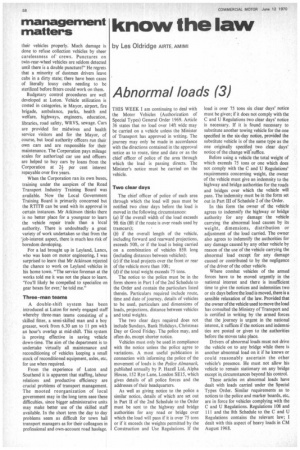know the law
Page 60

If you've noticed an error in this article please click here to report it so we can fix it.
by Les Oldridge AIRTE, AMIMI
Abnormal loads (3)
THIS WEEK I am continuing to deal with the Motor Vehicles (Authorization of Special Types) General Order 1969. Article 36 states that no load over 14ft wide may be carried on a vehicle unless the Minister of Transport has approved in writing. The journey may only be made in accordance with the directions contained in the approval notice as to route, time and date or as the chief officer of police of the area through which the load is passing directs. The Minister's notice must be carried on the vehicle.
Two clear days The chief officer of police of each area through which the load will pass must be notified two clear days before the load is moved in the following circumstances: (a) If the overall width of the load exceeds 9ft 6in (8ft if the route is over roads used by tramcars); (b) if the overall length of the vehicle, including forward and rearward projections, exceeds SOft, or if the load is being carried on a combination of vehicles 85ft long (including distances between vehicles); (c) if the load projects over the front or rear of the vehicle more than 10ft; (d) if the total weight exceeds 75 tons.
The notice to the police must be in the form shown in Part 1 of the 2nd Schedule to the Order and contain the particulars listed therein. Particulars required include route, time and date of journey, details of vehicles to be used, particulars and dimensions of loads, projections, distance between vehicles and total weights.
The two clear days required does not include Sundays, Bank Holidays, Christmas Day or Good Friday. The police may, and often do, except shorter notice.
Vehicles must only be used in compliance with the notice unless the police agree to variations. A most useful publication in connection with informing the police of the movement of loads is the Police Almonack published annually by P. Hazel] Ltd, Alpha House, 152 Rye Lane, London SEIS, which gives details of all police forces and the addresses of their headquarters.
As well as giving notice to the police a similar notice, details of which are set out in Part II of the 2nd Schedule to the Order must be sent to the highway and bridge authorities for any road or bridge over which the load will pass if it is over 75 tons or if it exceeds the weights permitted by the Construction and Use Regulations. If the load is over 75 tons six clear days' notice must be given; if it does not comply with the C and U Regulations two clear days' notice is necessary. If it is found necessary to substitute another towing vehicle for the one specified in the six-day notice, provided the substitute vehicle is of the same type as the one originally specified two clear days' notice of the change will'suffice.
Before using a vehicle the total weight of which exceeds 75 tons or one which does not comply with the C and U Regulations' requirements concerning weight, the owner of the vehicle must give an indemnity to the highway and bridge authorities for the roads and bridges over which the vehicle will pass. The indemnity must be in the form set out in Part HI of Schedule 2 of the Order.
In this form the owner of the vehicle agrees to indemnify the highway or bridge authority for any damage ' the vehicle carrying the abnormal load causes by its weight, dimensions, distribution or adjustment of the load carried. The owner also agrees to indemnify the authorities for any damage caused by any other vehicle by reason of the use of the vehicle carrying the abnormal load except for any damage caused or contributed to by the negligence of the driver of the other vehicle.
Where combat vehicles of the armed forces have to be moved urgently in the national interest and there is insufficient time to give the notices and indemnities two or six days before the load is moved, there is a sensible relaxation of the law. Provided that the owner of the vehicle used to move the load has consulted the Ministry of Transport and is certified in writing by the armed forces that the journey is urgent in the national interest, it suffices if the notices and indemnities are posted or given to the authorities before the moves take place.
Drivers of abnormal loads must not drive the vehicle on to any bridge while there is another abnormal load on it if he knows or could reasonably ascertain the other vehicle's presence. He must not allow his vehicle to remain stationary on any bridge except in circumstances beyond his control.
These articles on abnormal loads have dealt with loads carried under the Special Types Order. Similar requirements as to notices to the police and marker boards, etc, are in force for vehicles complying with the C and U Regulations. Regulations 108 and 111 and the 8th Schedule to the C and U Regulations contains the relevant law; I dealt with this aspect of heavy loads in CM August 1968.
























































































































